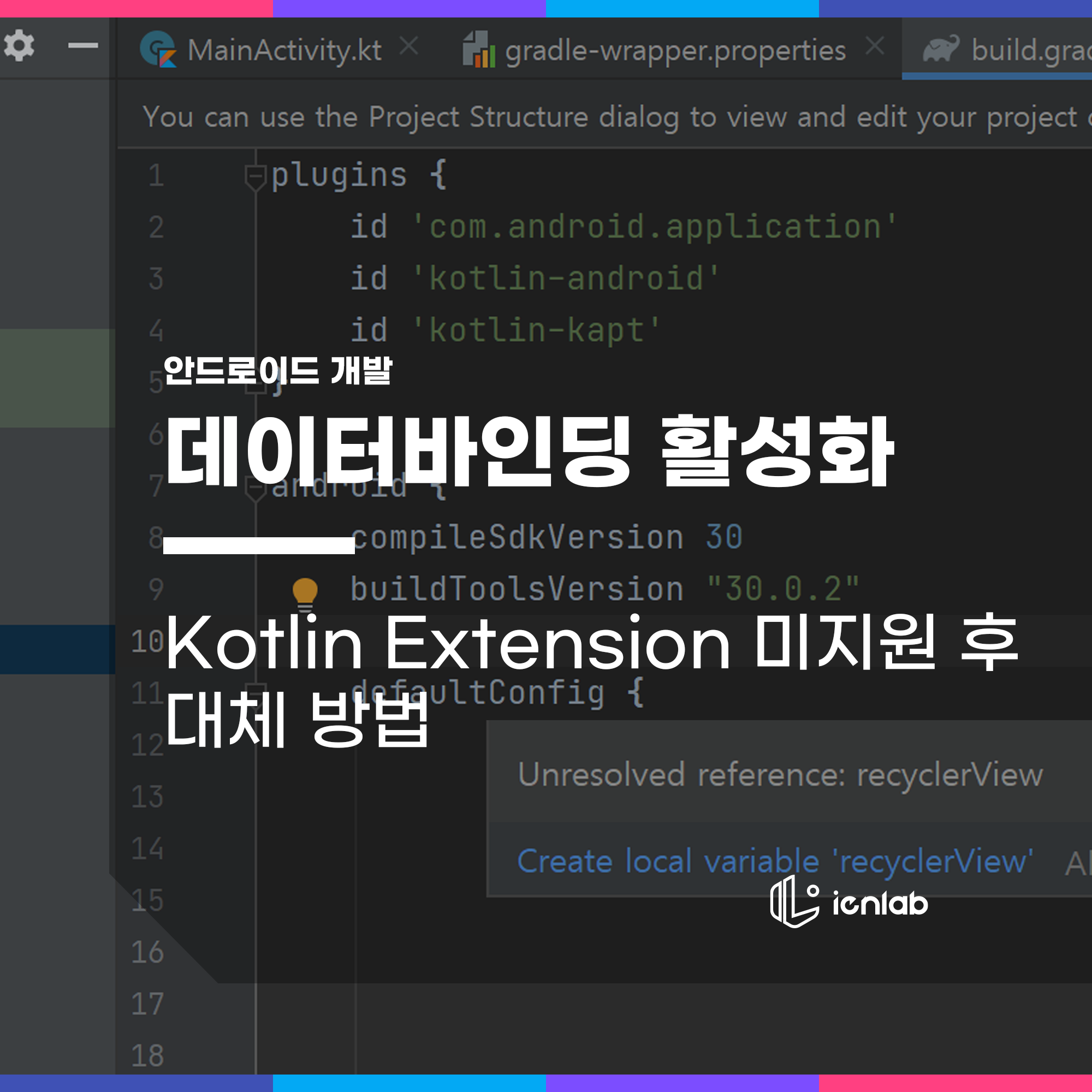
안녕하세요, 아이엔입니다. 요즘 지식IN에서 개발 답변을 달아주는데 재미가 들렸는데, 정말 자주 업로드되는 질문 중 하나가 바로 '코딩 강의 등에서 치라는 대로 쳤는데 Unresolved reference 오류가 난다' 류의 질문입니다. 이는 보통 강의와 학습자의 시간 차가 나서 일어나는 현상인데, 강의 촬영 및 작성 시기에는 코틀린 익스텐션 (Kotlin Extension)이 지원되었으나 현재는 코틀린 익스텐션을 권장하지 않기 때문에 기본적으로 제외되어 있기 때문입니다.
그렇기 때문에 코틀린 익스텐션을 제외한 방법으로 레이아웃의 뷰를 가져와야 하고, 그 방법 중 하나인 데이터바인딩을 이용해 이 문제를 해결할 것입니다.
build.gradle (모듈 수준)
먼저 build.gradle 파일의 가장 상단에 있는 plugins 부분에 다음 구문을 추가해 주세요.
plugins {
id 'com.android.application'
id 'kotlin-android'
id 'kotlin-kapt' // 이 부분
}그 다음으로는 데이터바인딩을 할 수 있도록 BuildFeatures에 dataBinding을 true로 바꿔줄 거에요. android {} 내에 kotlinOptions, compileOptions, buildTypes와 같은 들여쓰기 칸에 적어줍니다.
buildFeatures {
dataBinding = true
}이렇게 되면 build.gradle은 모두 완료되었습니다.
activity_main.xml (액티비티 레이아웃 XML)

원래 activity_main.xml이 생긴 모습인데, 데이터바인딩을 사용할 수 있도록 구조를 약간 바꿔야 하는데요, layout > data > variable, 그리고 data 밑에 루트 레이아웃이 들어가야 한다.
<?xml version="1.0" encoding="utf-8"?>
<layout xmlns:android="http://schemas.android.com/apk/res/android"
xmlns:app="http://schemas.android.com/apk/res-auto"
xmlns:tools="http://schemas.android.com/tools">
<data>
<variable
name="activity"
type="net.ienlab.timer.MainActivity" />
</data>
<androidx.constraintlayout.widget.ConstraintLayout
android:layout_width="match_parent"
android:layout_height="match_parent"
tools:context=".MainActivity">
<TextView
android:layout_width="wrap_content"
android:layout_height="wrap_content"
android:text="Hello World!"
app:layout_constraintBottom_toBottomOf="parent"
app:layout_constraintLeft_toLeftOf="parent"
app:layout_constraintRight_toRightOf="parent"
app:layout_constraintTop_toTopOf="parent" />
</androidx.constraintlayout.widget.ConstraintLayout>
</layout>이런 식으로 변환할 수 있습니다. variable에는 타입이 액티비티(레이아웃이 적용되는 액티비티)인, 변수 이름이 activity를 만들어 줍니다. 그리고 이제 코틀린 파일로 가 봅시다.
MainActivity.kt
lateinit var binding: ActivityMainBinding액티비티 수준에서 binding이라는, ActivityMainBinding 타입의 변수를 선언해 줍니다.
override fun onCreate(savedInstanceState: Bundle?) {
super.onCreate(savedInstanceState)
setContentView(R.layout.activity_main)
}이게 원래 onCreate였는데, setContentView 부분을 약간 바꿔 주어야 합니다.
binding = DataBindingUtil.setContentView(this, R.layout.activity_main)
binding.activity = this이렇게 바꾸어 주시면 됩니다. 그러면 이제 실제로 사용해봅시다.
실제 사용
<TextView
android:id="@+id/text_view"
android:layout_width="wrap_content"
android:layout_height="wrap_content"
android:text="Hello World!"
app:layout_constraintBottom_toBottomOf="parent"
app:layout_constraintLeft_toLeftOf="parent"
app:layout_constraintRight_toRightOf="parent"
app:layout_constraintTop_toTopOf="parent" />이제 아이디가 text_view인 TextView 타입의 뷰를 하나 만들어 놓았다고 가정합시다. 원래 코틀린 익스텐션의 경우, text_view.text = "~~" 이렇게 할 수 있었겠지만, 데이터바인딩의 경우 binding.textView.text = "~~" 이렇게 접근이 가능합니다. 주의할 점은, snake_case와 CamelCase의 차이인데, 아이디를 snake_case로 해두었더라도 코틀린 파일에서 뷰를 접근할 때는 CamelCase로 접근하게 됩니다. 그러면 다음과 같이 지정할 수 있습니다.
binding.textView.text = "Hello World"읽어주셔서 감사합니다.